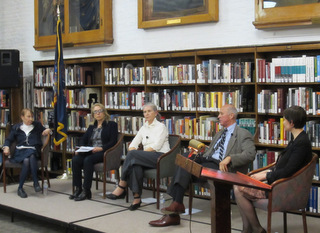Four past Landmarks chairs gathered to discuss what makes a chair effective, how to make the landmarking process more efficient, and challenges facing the Commission. On April 25th, 2013, at the General Society of Mechanics & Tradesmen, four past chairs of the NYC Landmarks Preservation Commission participated in a panel discussion titled “Past Leaders Look to The Future.” The event was co-sponsored by the Society and a number of preservationist organizations, including the New York Preservation Archive Project, Historic Districts Council, Fine Arts Federation, and the Institute of Classical Architecture & Art.
Anthony C. Wood, of the New York Preservation Archive Project, introduced the event, noting that a new mayoral administration will likely mean the appointment of a new Commission chair. Wood hoped the event will “help inform” the thinking of mayoral candidates, will serve to define the challenges facing the next chair, what characteristics the next chair must possess, and to offer advice. Liz McEnaney moderated the discussion, which included former Chairs, Beverly Moss Spatt (1974 to 1978), Kent L. Barwick (1978 to 1983), Laurie Beckelman (1990 to 1994), and Sherida Paulsen (2001 to 2003).
Moss Spatt took the podium to make recommendations for the next chair of the Commission. She stated that the purpose of preservation is to achieve an understanding of social, cultural, architectural, technical, political, and philosophical human qualities, and that preservation is “the tissue that holds us all together.” She said a consortium of development interests are seeking to “eviscerate” the authority of the Commission, a movement which the next chair will have to combat. She further stated that the Commission will need to reckon with the planned East Midtown Rezoning which she sees as a threat to preservation priorities and a strain on the City’s infrastructure. (See CityLand’s coverage here.) Moss Spatt also argued for transparency, saying the community should have knowledge of, and involvement in, every stage of the designation process.
Laurie Beckelman and Sherida Paulsen noted that a large amount of designations were made during the Bloomberg administration with Robert B. Tierney at the helm of Commission. Beckelman said that though there have been losses, preservationists “have a lot celebrate” in what has been saved in the City. Beckelman commended the stewardship of current Chair Tierney, calling the amount of designations during the Bloomberg administration “remarkable.”
Paulsen said it is “insane” that the Commission, the Department of Buildings, the City Planning Commission, and the Department of Transportation are not coordinated in their efforts, and the next chair should seek to address the issue. Paulsen said that a mayoral administration needs to balance preservation and development, and that preservationists need to “advocate effectively.” She said the East Midtown Rezoning would fail only if other stakeholders are aware of the plan’s flaws, and urged preservationists to seek common ground with other interest groups. Moss Spatt, however, believes that the next chair should be non-political and a preservationist.
The former commissioners also talked about the political realities of chairmanship, which is often about relationships. Beckelman said that Jennifer Raab, who served as Chair from 1994 to 2001, was able to designate properties in lower Manhattan because of her access to Mayor Rudolph Giuliani. Kent Barwick concurred, stating that the best way to be an effective chair is to “be very good friends with the mayor.” Barwick said anyone under consideration for the chairmanship should not accept the position without a clear commitment from City Hall of its support.
The speakers also addressed the relationship between the Commission and City Planning. Beckelman described her struggle to prevent the Commission from being merged into City Planning. Moss Spatt characterized City Planning as “a very powerful agency” which has long had a difficult relationship with the Commission. She said City Planning has strayed from its original conception as an independent agency, and now “whatever the mayor wants, the City Planning Commission gives.”
Some contested the idea that the Commission is an opaque organization, with Paulsen stating that the amount of community outreach has increased in the life of the Commission. She also said that the public needs to be better educated about the process that takes place before a potential designation reaches the full Commission. Beckelman also believes that the landmarking process had grown more open. Barwick found part of the problem is the nature of the process, when a designation “leaves the desk of the Landmarks Commission, it enters pure politics,” rather than being the objective decision of experts.
Past Leaders Look to the Future, General Society of Mechanics & Tradesmen (April 25, 2013).


